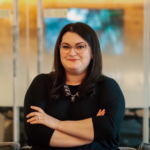Thought Leadership
Designing for Broadway and Beyond
Stephanie Sciandra Smith: Chris, you’ve been with us for almost three years now, right?
Chris Hemingway: (laughs) Yes, almost three years. Time flies, doesn’t it?
Stephanie: Before we dive into all things Broadway and live events, you made a big shift from film and TV to live theater. Now that you’ve been with us for a while, what’s that transition been like, and what parts of your film and TV background do you find most helpful in your role today?
Chris: That’s such a loaded question—it seems simple, but it’s actually complicated!
Entertainment advertising has a lot of similarities across the board, but Broadway does have its unique considerations. I’d say what’s been most interesting is blending the two worlds. Coming from film and TV, I have this visual and storytelling sensibility that I’ve been able to apply here in Broadway key art.
Stephanie: You used a phrase in a meeting recently that stuck with me—”our process isn’t different, but our perspective is.” I’m curious, when you start a new project, what’s the first thing you think about? How do you get into the mindset of both the creators and the audience?
Chris: I’ll admit, the first thing I do is focus on what intrigues me about the project—what draws me in personally. Once I’ve explored that personal curiosity, I then dive into what we’ve heard from the creators and what will intrigue the audience. It’s about balancing your own instincts with what will resonate with the people who need to see it. And honestly, it’s fascinating to see how different designers interpret the same information.
Stephanie: Speaking of interpretation, you’ve worked in Chicago, LA, and New York. How have these cities influenced your creative style?
Chris: Well, I actually got my start in Chicago, designing posters for my high school theater. But in LA, the way advertising works is so different because you’re always in your car, seeing billboards from a distance. New York is much more intimate—you’re face-to-face with ads, especially in the subways, which changes the relationship you have with them. That proximity has definitely influenced the way I think about key art here.
Stephanie: You’ve collaborated with so many creative teams over the years. Is there a particular project that pushed your creative limits?
Chris: Every project pushes you in some way, but I’d say working Aladdin’s 10th Anniversary campaign for Disney Theatrical Group was a standout. We did everything from station takeovers to massive installations, like the 15-foot lamp on the theater. It’s one of those moments where you’re like, “Wow, we really made something special.”
Stephanie: When you talk about pushing creative limits, what does that mean to you?
Chris: It’s about making bold statements, whether that’s through color, size, or concept. I don’t think about boundaries as limitations—they’re opportunities to explore. The worst thing that can happen is for someone to feel nothing when they look at your work. You want to evoke some kind of reaction, to make people stop and think.
Stephanie: As Broadway and entertainment evolve, where do you see key art development going in the next few years?
Chris: Motion is definitely a growing trend. The ability to create dynamic, moving posters that still capture the essence of a show is exciting.
Stephanie: Do you see AI playing a role in that?
Chris: AI is an interesting tool, but it’s not a replacement for human creativity. It might help people visualize ideas they can’t quite create themselves, but right now, it’s still a bit of a gray area in terms of sourcing.
Stephanie: Last question—what does success look like for you in a creative field?
Chris: Success, for me, is making the client happy and creating something that genuinely connects with people. Awards are great, but the real win is when a piece of art embodies all the hard work a team has put into a project. It’s about being a conduit for their vision.
Join our newsletter list to hear our insights, data, and perspectives on your industry.
"*" indicates required fields
